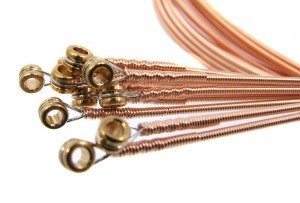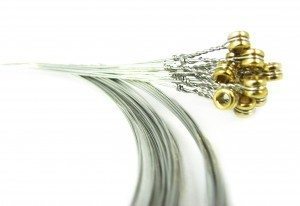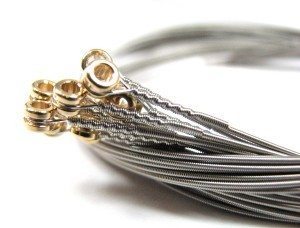The Open E tuning is not seen as often as the more popular GDG and DAD tunings, but it is a great alternative for cigar box guitar players, especially if you are playing a lot of blues. Shane Speal used this tuning on his recent album Holler!, on the track Big Leg Woman/Swing the Hammer.

This article follows the format used in our previous articles on cigar box guitar tuning. If you have read those articles, you may find some of this repetitive – feel free to skip down to the bottom where the specific string sizes are listed! – Gitty
Because of the bluesy feel of this tuning, we purposefully used a little smaller gauge strings on this tuning. The means that the strings are a little looser on the instrument, which is good for playing slide blues. If you like things a little tighter, try bumping up to medium or even heavy-gauge strings.
I have actually personally tested and confirmed (and revised!) the string gauges listed below during the writing of this article, so this isn’t just theory and guessing!
Before we dive in, a disclaimer: these recommendations are made based on our experimentation in the C. B. Gitty shops, and it is what we have found to work. Other people may have different opinions, and they are welcome to them. I’m not trying to set any standards or lay down any laws – I am just going to tell you what works for us.
The Four Possible EBE Tunings
Basically, on a 3-string cigar box guitar with a scale length in the range of 24 to 25 1/2 inches (scale length being the distance between the nut and the bridge), there are 4 different configurations of EBE that you can have, ranging from the lowest/bassiest to the highest/most trebly. Theoretically there are more potential combinations, but we’re just focusing on the cases where you have 3 strings of different sizes, strung from low to high pitch:
- Low-Low-Middle (Low E, Low B, Middle E)
- Low-Low-High (Low E, Low B, High E)
- Low-Middle-High (Low E, Middle B, High E)
- Middle-Middle-High (Middle E, Middle B, High E)
 Each one of these will have a different overall sound and feel. The first option uses all wound strings, and will have the strongest bass of the four. The other three varieties use a mix of wound strings and that nice high E string as well, and will have that higher-pitch influence which can be very nice.
Each one of these will have a different overall sound and feel. The first option uses all wound strings, and will have the strongest bass of the four. The other three varieties use a mix of wound strings and that nice high E string as well, and will have that higher-pitch influence which can be very nice.
Deciding which option is right for you is mostly a matter of preference, and experimentation. All four can be used to play tablature and lessons intended for guitars tuned to EBE. You have to decide whether you want the low growly bass of the low strings, the treble of the high strings, or a mix).
Just Looking for Gitty’s Recommendation? Here You Go
If I had to arbitrarily make a recommendation of which one you should use, I would probably go with #3: Low E, Middle B, High E. In my opinion, this mix of bass and treble gives the fullest sound and the most versatility. The fourth option (middle E middle B high E) is also very nice. As mentioned above, everyone’s tastes differ, so try them out and see what you like!
Now, on to Strings
Basically, there are 5 potential strings that are needed to achieve these 4 tunings. They are:
- Low E
- Low B
- Middle E
- Middle B
- High E
If you think of a standard 6-string guitar, or if you want to use a standard guitar string pack to do these tunings, you can think of it like this:
- Low E – this is the same as the low E string on a standard guitar – the biggest/lowest-pitched wound string.
- Low B – take the low A string (the second biggest wound string) and tune it up a full step to B.
- Middle E – take the middle D string (the third biggest wound string) and tune it up a full step to E.
- Middle B – this is the same as the middle B string on a standard guitar – the bigger of the two unwound/plain steel strings.
- High E – this is the same as the high E string on a standard guitar – the smallest unwound/plain steel string.
String Weights and Gauges
If you want to know recommended string gauges for buying in bulk, then the chart below should help you pick out the specific gauges you’ll need. Remember that moving to a larger string gauge means you’ll have to crank it tighter to reach the same pitch, compared to a smaller gauge.
Also remember that the chart below is specifically for “standard” scale instruments, that fall an inch or so on either side of a 25″ scale length.
We give both “heavy”, “medium” and “light” recommendations below, so you can pick a set best suited to your instrument. Heavier strings will have to be cranked tighter than light string sets to reach the right pitch, and this will put more tension on your guitar, bowing your neck more, etc. I recommend starting with the lighter gauge strings and experimenting from there.
These sizes should work with both acoustic and electric guitar strings. Generally electric guitars are strung on the lighter gauge size. The gauges below are hyperlinked to the bulk strings listings at CBGitty.com, where available.
| Desired Note/Pitch | Xtra Light/Light Gauge | Light/Medium Gauge | Medium/Heavy Gauge |
| Low E | .048″ Wound | .050″ Wound | .052″+ Wound |
| Low B | .036″ Wound | .038″ Wound | .042″+ Wound |
| Middle E | .026″ Wound | .028″ Wound | .032″+ Wound |
| Middle B | .014″ Plain Steel | .016″ Wound | .017″+ Wound |
| High E | .010″ Plain Steel | .012″Plain Steel | .013″+ Plain Steel |
Finally! Specific String Size Sets for Specific Tunings
So from all of this, we can get some recommended string sizes to achieve the 4 tunings mentioned above. For this example I’ll list the “Xtra Light/Light Gauge” sizes, but you should be able to easily pick out the medium or heavy gauge sizes if you want. We have included an audio clip of what each string set sounds like to help you get an idea. As mentioned above, I purposefully kept these strings a little lighter in gauge so they would have less tension and have that looser more bluesy feel when played.
- Low E – Low B – Middle E: .048″ Wound, .036″ Wound, .026″ Wound
- Low E – Low B – High E: .048″ Wound, .036″ Wound, .010″ Plain Steel
- Low E – Middle B – High E: .048″ Wound, .014″ Plain Steel, .010″ Plain Steel
- Middle E – Middle B – High E: .026″ Wound, .014″ Plain Steel, .010″ Plain Steel
 The Wiggle Room Factor: you can generally get by with a little larger or little smaller string for any given pitch. Each string has its ideal tension zone, but the edges of that zone are a bit gray. If you keep breaking a string trying to hit a particular pitch, try a smaller gauge string! If a string seems too loose and flappy, move to a larger gauge string.
The Wiggle Room Factor: you can generally get by with a little larger or little smaller string for any given pitch. Each string has its ideal tension zone, but the edges of that zone are a bit gray. If you keep breaking a string trying to hit a particular pitch, try a smaller gauge string! If a string seems too loose and flappy, move to a larger gauge string.
So there you have it! Hopefully this will make this sometimes arcane-seeming subject a little easier to understand for folks.
Thanks for reading, I hope you found it useful!


Hello, David. So I’m assuming you’re looking for feedback on an open E5 tuning (EBE) and an open E major tuning (EG#B or in this case G#BE). While there’s quite a bit that could be unpacked to answer your great question, I’ll sum it up with the following: The open5 tuning is generally easier to play 3-string slide guitar with a slide to barre all three strings. The open major tuning is generally easier to finger some chord shapes than it is with the open5 tuning. That open5 tuning can be a bear to stretch the fingers for certain chord shapes, especially on CBGs using a “longer” or more “conventional” scale length (~ 25-inches). But to use a slide to barre all three strings in an open major tuning makes it a challenge to play anything but major chords. Hope this helps! If you have any further questions, or would prefer more clarity, you can reach us at [email protected]. We’re always happy to help.
EBE vs G#BE?
Are there advantages/differences?
Thank you!
Thanks for the info.
Hi ,
I bought a nice homemade 4 string…..and I’m messing with tunings , and trying stuff like delta blues. It’s all early days. My Fender amp helps.
I was having trouble choosing which key or pattern – until I asked myself the question.
When does my fattest string /lowest note sound really comfortable ? Not too slack and not too tight.
That seems to be making the decision MUCH easier. I then just look to the closest indicated pattern.
This is great – I have a rather ‘bassy’cbg, the lessons learned here, using thinner strings, will help add some sparkle 😉 Thanks for sharing.
WOW, great article , the sound cuts were cool. I’m kind of new at building CBG’s , I didn’t think string gage really mattered. I need to rethink that.
Thanks